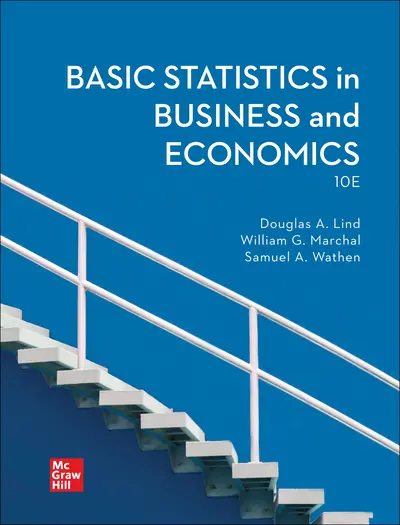
Orders within the United States are shipped via FedEx or UPS Ground. For shipments to locations outside of the U.S., only standard shipping is available. All shipping options assume the product is available and that processing an order takes 24 to 48 hours prior to shipping.
View PriceNote: Connect can only be used if assigned by your instructor.
Learn more about Connect >Orders within the United States are shipped via FedEx or UPS Ground. For shipments to locations outside of the U.S., only standard shipping is available. All shipping options assume the product is available and that processing an order takes 24 to 48 hours prior to shipping.
View Price* The estimated amount of time this product will be on the market is based on a number of factors, including faculty input to instructional design and the prior revision cycle and updates to academic research-which typically results in a revision cycle ranging from every two to four years for this product. Pricing subject to change at any time.
Quick Actions (Only for Validated Instructor Accounts):
Request a Print Sample Contact a RepBasic Statistics in Business & Economics provides students majoring in management, marketing, finance, accounting, economics, and other fields of business administration with an introductory survey of descriptive and inferential statistics. Many examples and exercises that focus on business applications are used to illustrate the application of statistics, but also relate to the current world of the college student. A previous course in statistics is not necessary, and the mathematical requirement is first-year algebra.
Students are given every step needed to be successful in a basic statistics course. This step-by-step approach enhances performance, accelerates preparedness, and significantly improves motivation. Understanding the concepts, seeing and doing plenty of examples and exercises, and comprehending the application of statistical methods in business and economics are the focus of this book.
Today, the practice of data analytics is widely applied to big data. The practice of data analytics requires skills and knowledge in several areas. Computer skills are needed to process large volumes of information. Analytical skills are needed to evaluate, summarize, organize, and analyze the information. Critical thinking skills are needed to interpret and communicate the results of processing the information. This text supports the development of basic data analytical skills with the end of each chapter sections called Data Analytics providing the instructor and student with opportunities to apply statistical knowledge and statistical software to explore several business environments. Interpretation of the analytical results is an integral part of these exercises.
A variety of statistical software is available to complement the 10th edition. Microsoft Excel includes an add-in with many statistical analyses. MegaStat is an add-in available for Microsoft Excel. Minitab and JMP are stand-alone statistical software packages available to download for either PC or Mac. In the text, Microsoft Excel, Minitab, and MegaStat are used to illustrate statistical software analyses. The text also includes references or links to Excel tutorials in Connect. These provide users with clear demonstrations using statistical software to create graphical and descriptive statistics and statistical analyses to test hypotheses.
Digital resources within McGraw Hill Connect® help students apply what they've learned and achieve higher outcomes in the course. Connect is the only integrated learning system that empowers students by continuously adapting to deliver precisely what they need when they need it and how they need it so that class time is more engaging and effective.
Chapter 1: What is Statistics?
Chapter 2: Describing Data: Frequency Tables, FrequencyDistributions, and Graphic Presentation
Chapter 3: Describing Data: Numerical Measures
Chapter 4: Describing Data: Displaying and Exploring Data
Chapter 5: A Survey of Probability Concepts
Chapter 6: Discrete Probability Distributions
Chapter 7: Continuous Probability Distributions
Chapter 8: Sampling, Sampling Methods, and the Central LimitTheorem
Chapter 9: Estimation and Confidence Intervals
Chapter 10: One-Sample Tests of Hypothesis
Chapter 11: Two-Sample Tests of Hypothesis
Chapter 12: Analysis of Variance
Chapter 13: Correlation and Linear Regression
Chapter 14: Multiple Regression Analysis
Chapter 15: Nonparametric Methods: Nominal-Level HypothesisTests
Appendixes: Data Sets, Tables, Answers
Douglas Lind
Douglas A. Lind earned his B.S. in Business from Bowling Green State University, and his Ph.D. and M.B.A. from the University of Toledo. He is Emeritus Professor at Coastal Carolina University and the University of Toledo. Dr. Lind is a co-author of Statistical Techniques in Business and Economics with the late Robert D. Mason and William G. Marchal. He has more than 38 years of college teaching experience, including teaching statistics at the introductory, intermediate, and advanced undergraduate levels, as well as graduate courses in statistics and research methods. Dr. Lind is a past recipient of the Tony DeJute Outstanding Teacher Award.
William Marchal
William G. Marchal earned his B.S. in mathematics from the University of Dayton, his M.A. in mathematics from Catholic University of America, and his D.Sc. in operations research from George Washington University. He is Emeritus Professor of Information Systems and Operations Management at the University of Toledo College of Business Administration. Dr. Marchal has held visiting appointments at the University of Michigan and at George Mason University. He has worked at the Executive Office of the District of Columbia government, the George Washington University Institute for Management Science, and the U.S. Army Chemical Research and Development Center. He has also served as an associate editor of Naval Research Logistics.
Samuel Wathen
Samuel A. Wathen earned his B.S. in forestry from the University of Illinois, an M.B.A. from Oklahoma State University, an M.S. in forest biometrics from Virginia Polytechnic Institute and State University, and his Ph.D. in business administration from the University of Minnesota. He is Distinguished Professor Emeritus of Management and Decision Sciences in the E. Craig Wall Sr. College of Business Administration at Coastal Carolina University. Dr. Wathen's research interests include applied statistics, teaching methods, and manufacturing and service process design. Most recently, he published the article “Using Real‐Life Major League Baseball Data in an Introductory Statistics Course” in the Decision Sciences Journal of Innovative Education.